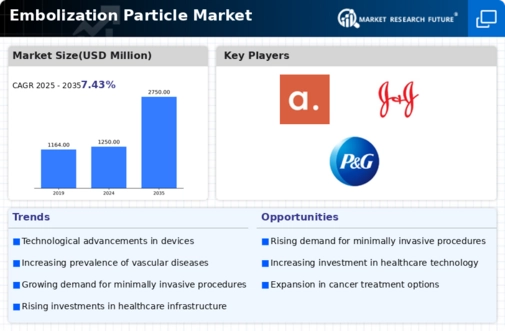Increasing Prevalence of Vascular Diseases
The rising incidence of vascular diseases in the US is a critical driver for the embolization particle market. Conditions such as arteriovenous malformations and tumors necessitate effective treatment options, leading to a growing demand for embolization procedures. According to recent data, vascular diseases account for a substantial portion of healthcare expenditures, with costs exceeding $200 billion annually. This trend indicates a pressing need for innovative solutions in the embolization particle market, as healthcare providers seek to improve patient outcomes while managing costs. The increasing prevalence of these diseases is likely to propel the market forward, as more patients require targeted therapies that utilize embolization particles.
Advancements in Medical Imaging Technologies
The evolution of medical imaging technologies plays a pivotal role in enhancing the efficacy of embolization procedures. Innovations such as MRI, CT scans, and ultrasound have improved the precision of diagnosis and treatment planning, thereby driving the embolization particle market. Enhanced imaging capabilities allow for better visualization of vascular structures, which is essential for the successful deployment of embolization particles. As imaging technologies continue to advance, the embolization particle market is expected to benefit from increased adoption rates, as healthcare professionals gain confidence in the accuracy and effectiveness of these procedures. This trend suggests a synergistic relationship between imaging advancements and the growth of the embolization particle market.
Enhanced Research and Development Activities
The embolization particle market is experiencing a surge in research and development activities, which is fostering innovation and expanding treatment options. Pharmaceutical companies and research institutions are investing in the development of new embolization particles with improved efficacy and safety profiles. This focus on R&D is crucial, as it leads to the introduction of novel products that can address unmet medical needs. The US market is particularly conducive to such advancements, given its robust healthcare ecosystem and access to funding. As R&D efforts continue to yield promising results, the embolization particle market is expected to witness significant growth, driven by the introduction of cutting-edge therapies.
Growing Investment in Healthcare Infrastructure
The ongoing investment in US healthcare infrastructure is a significant driver for the embolization particle market. As hospitals and clinics expand their facilities and upgrade their equipment, there is a corresponding increase in the availability of advanced treatment options, including embolization procedures. The US government has allocated substantial funding to improve healthcare services, which is likely to enhance access to embolization therapies. This investment trend indicates a commitment to improving patient care, which may lead to a higher demand for embolization particles. Consequently, the embolization particle market is poised for growth as healthcare providers seek to incorporate these innovative solutions into their treatment protocols.
Rising Awareness of Minimally Invasive Treatments
There is a notable increase in patient awareness regarding the benefits of minimally invasive treatments, which is positively impacting the embolization particle market. Patients are increasingly seeking alternatives to traditional surgical procedures due to shorter recovery times and reduced risks. This shift in patient preference is prompting healthcare providers to adopt embolization techniques more widely. As a result, the market for embolization particles is likely to expand, driven by the demand for less invasive options. Educational campaigns and patient advocacy efforts are further contributing to this trend, as they highlight the advantages of embolization procedures in treating various medical conditions.














Leave a Comment